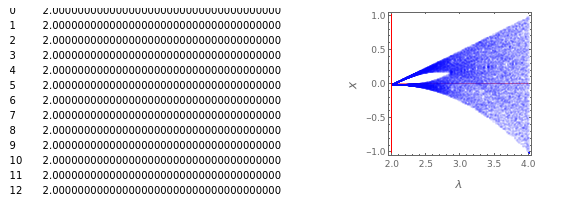High-Precision Newton Algorithm for Generalized Logistic Maps with Unimodality z
High-Precision Newton Algorithm for Generalized Logistic Maps with Unimodality z
This Demonstration shows a table of superstable parameter values of a period-doubling periodic attractor. The test map is defined as ()==λ(1-|)2-1, which generalizes the well-known logistic map ()==λ(1-). Here is an iteration number, , and is the unimodality (or the degree) of the local maximum of (x). The superstable parameter values are used for the renormalization group analysis of many low-dimensional dynamical systems with chaotic behavior. See the references [1–4].
f
GLM
x
i
x
i+1
x
i
z
|
f
LM
x
i
x
i+1
x
i
x
i
i
-1≤≤1
x
i
z
f
GLM
The algorithm used is a high-precision Newton algorithm with fixed precision arithmetic. For , superstable parameter values for [x] are exactly the same as those for [x]. In this Demonstration, the required number types and their interval ranges are as follows:
z=2
f
GLM
f
LM
1. is a rational number between 1 and 4.
z
2. .
1≤<4
λ
L
3. is an integer, with 0 for the fastest calculation and the poorest visualization; 50 for moderate speed and moderate visualization; and 500 for the slowest speed with good visualization.
N≥0
(4) is an integer, . You can select higher values manually, but at your own risk. For example, with =31, the author's computer calculated the super-stable parameter values for for one week! The minimum precision length used for this calculation was 40.
r
max
2≤≤13
r
max
r
max
z=2
(5) is an integer used in the fixed precision arithmetic. The Newton algorithm for finding superstable parameter values with a low precision may result in wrong answers. High precision is good but it requires a long calculation time. This Demonstration is designed for .
p
16≤p≤40
